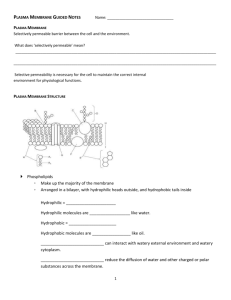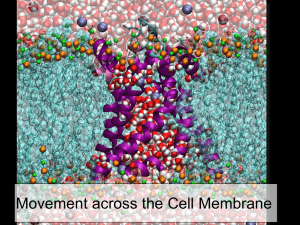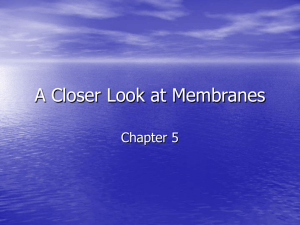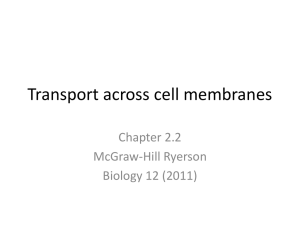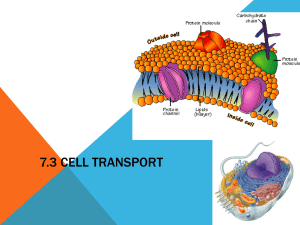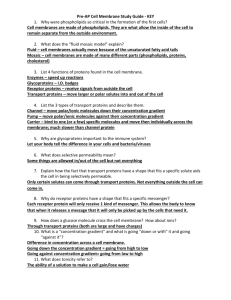Chapter 7: Membrane Structure and Function
advertisement
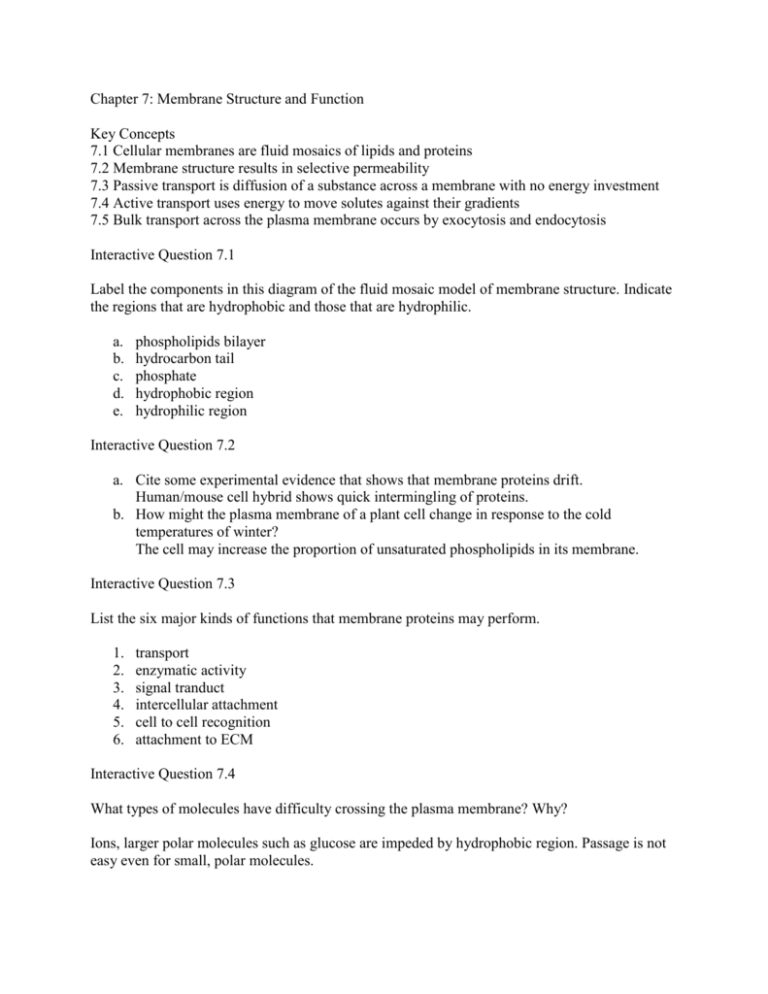
Chapter 7: Membrane Structure and Function Key Concepts 7.1 Cellular membranes are fluid mosaics of lipids and proteins 7.2 Membrane structure results in selective permeability 7.3 Passive transport is diffusion of a substance across a membrane with no energy investment 7.4 Active transport uses energy to move solutes against their gradients 7.5 Bulk transport across the plasma membrane occurs by exocytosis and endocytosis Interactive Question 7.1 Label the components in this diagram of the fluid mosaic model of membrane structure. Indicate the regions that are hydrophobic and those that are hydrophilic. a. b. c. d. e. phospholipids bilayer hydrocarbon tail phosphate hydrophobic region hydrophilic region Interactive Question 7.2 a. Cite some experimental evidence that shows that membrane proteins drift. Human/mouse cell hybrid shows quick intermingling of proteins. b. How might the plasma membrane of a plant cell change in response to the cold temperatures of winter? The cell may increase the proportion of unsaturated phospholipids in its membrane. Interactive Question 7.3 List the six major kinds of functions that membrane proteins may perform. 1. 2. 3. 4. 5. 6. transport enzymatic activity signal tranduct intercellular attachment cell to cell recognition attachment to ECM Interactive Question 7.4 What types of molecules have difficulty crossing the plasma membrane? Why? Ions, larger polar molecules such as glucose are impeded by hydrophobic region. Passage is not easy even for small, polar molecules. Interactive Question 7.5 A solution of 1 M glucose is separated by a selectively permeable membrane from a solution of 0.2 M fructose and 0.7 M sucrose. The membrane is not permeable to the sugar molecules. Indicate which side initially has more free water molecules and which has fewer. Show the direction of osmosis. Side A has fewer free molecules. Side B initially has the higher amount of water. Water goes from B to A. Interactive Question 7.6 a. What osmotic problems do freshwater protists face? The protists will gain water from their hydrophobic environment. b. What adaptations may help them osmoregulate? Membranes could be less permeable to water and contractible vacuoles expel water. Interactive Question 7.7 a. The ideal osmotic environment for animal cells is isotonic b. The ideal osmotic environment for plant cells is hypotonic. Interactive Question 7.8 Why is facilitated diffusion considered passive transport? Facilitated diffusion is still passive because solutes move down its concentrated gradient. Interactive Question 7.9 The Na+-K+ pump, the major electrogenic pump in animal cells, exchanges sodium ions for potassium ions, both of which are cations. How does this exchange generate a membrane potential? 3 Na+ ions are pumped out and two K+ ions are pumped in, resulting in a net movement of + charge from cytoplasm to extracellular flow. Interactive Question 7.10 a. How is cholesterol, which is used for the synthesis of other steroids and membranes transported into human cells? Human cells are receptor-mediated endocytosis; to take in cholesterol. b. Explain why cholesterol accumulates in the blood of individuals with the disease familial hypercholestermia. LDL receptor proteins in the plasma membrane are defective and low-density lipoproteins cannot bind and be transported into the cell. Structure Your Knowledge 1. Create a concept map to illustrate your understanding of osmosis. This exercise will help you practice using the words hypotonic, isotonic, and hypertonic, and it will help you focus on the effect of these osmotic environments on plant and animal cells. Explain your map to a friend. Osmosis is the diffusion of water through a selectively permeable membrane from a no net movement if hypotonic solution hypertonic solution in which has has in which isotonic solution in which animal cell will lyse lower higher animal cell animal cell is normal and solute solute will shrivel and plant cell concentration concentration and plant cell is flaccid is turgid and and plant cell more water less water will plasmolyse available available to move to move 2. The following diagram illustrates passive and active transport across a plasma membrane. Use it to answer questions a-d. a. Which section represents facilitated diffusion? How can you tell? II represents facilitated diffusion. The solute is moving through a transport protein and down a concentration gradient. The cell does not expend energy in this transport. Polar molecules and ions may move by facilitated diffusion. b. Which section shows active transport? List two ways how you can tell? III represents active transport because the solute is clearly moving against its concentration gradient and the cell is expending ATP to drive this transport against the gradient. c. Which section shows diffusion? What types of solute molecules may be moved by this type of transport? I illustrates diffusion through the lipid bilayer. The solute molecules must be nonpolar or very small polar molecules. d. Which of these sections are considered passive transport? I and II, Both diffusion and facilitated diffusion are considered passive transport because the solute moves down its concentration gradient and the cell does not expend energy in the transport. Multiple Choice 1. c. cell-cell recognition. pg. 129 2. b. the hydrocarbon tails. pg. 126 3. a. It is a passive process in cells without walls, but an active one in cells with walls. pg. 132 4. e. all of the above. pg. 125 5. d. shriveling of the cell. pg. 132-133 6. a. electrochemical gradient. pg. 135 7. e. increasing the number of phospholipids with unsaturated hydrocarbon tails. pg. 126 8. c. become turgid. pg. 132 9. b. They can concentrate solute molecules on one side of the membrane. pg. 133-134 10. a. movement of cations into the cell. pg. 134-136 11. e. transport of one solute against its concentration gradient in tandem with another that is diffusing down its gradient. pg. 136 12. a. ligands and coated pits. pg. 137 13. b. sodium-potassium pump. pg. 134 14. c. the pinching in of the plasma membrane around small droplets of external liquid. pg. 138 15. b. the soil solution becomes hypertonic, causing the cells to lose water. pg. 132 16. b. facing inside the ER lumen and inside the transport vesicle. pg. 127-128 17. e. a middle region composed of alpha-helical stretches of hydrophobic amino acids, with hydrophilic regions at both ends of the protein. pg. 127-128 18. c. has an equal solute concentration. pg. 132-133 19. e. water and glucose. pg. 132-133 20. a. The water level is higher in side A than in side B. pg. 132-133 21. d. transport proteins…down. pg. 133-134 22. b. isotonic. pg. 132 23. d. receptor-mediated endocytosis. pg. 137-138 24. c. a phospholipids bilayer with proteins embedded in and attached to it. pg. 125 25. d. It is hypertonic to the plant cells, but its solute can cross the plant cell membranes. pg. 132-133
